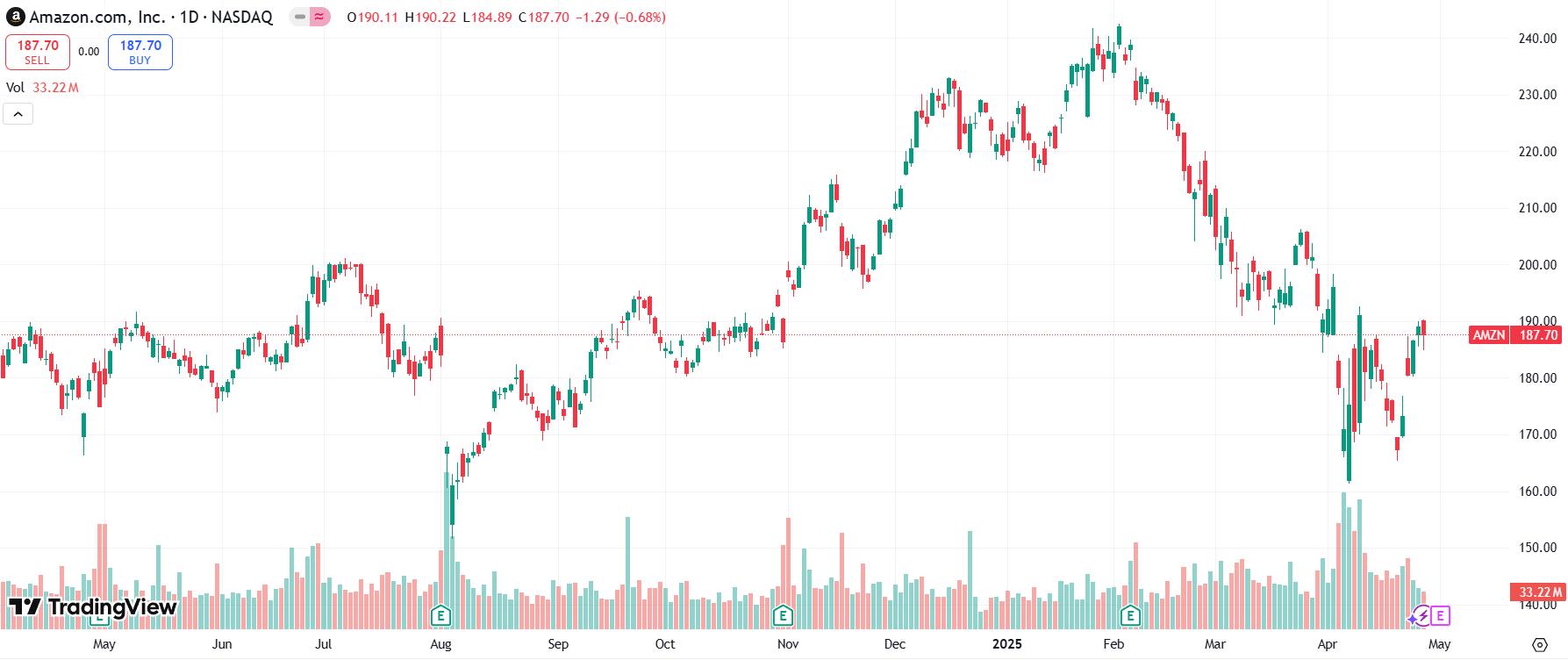Amazon Q1 2025 Earnings Preview: Navigating Tariffs, E-commerce, and Cloud Growth
TradingKey - Amazon is gearing up to unveil its Q1 2025 earnings, and investors are buzzing with anticipation. The market generally expects the company's revenue to be between $151 billion and $155.5 billion, a YoY increase of about 5% to 9%. Operating profit is expected to be between $14 billion and $18 billion, with an operating profit margin of approximately 9% to 11.5%. EPS is expected to be between $1.12 and $1.15, a slight increase from the same period last year. Despite tariff pressure and macroeconomic uncertainty, Amazon is still expected to maintain steady growth in revenue and profits with its scale advantages and technological innovation. This Q1 financial report is not only a reflection of performance, but also an important reference for observing how Amazon responds to challenges and plans for the future. 
Source: Tradingview
Tariffs: A Bumpy Road, but Amazon’s Got Options
Tariffs are the elephant in the room. With U.S. tariffs on Chinese goods hitting as high as 145% and exemptions for low-value packages scrapped, competitors like Shein and Temu are feeling the heat. Some of their products have seen price hikes of over 300%, with Temu doubling prices to offset 130%-150% import fees. For Amazon, the impact is less severe but still worth watching. Unlike its Chinese rivals, Amazon’s massive scale and diverse supply chain give it a buffer. It can pass some of these costs to consumers and third-party sellers without taking a big hit to its bottom line, at least for now.
But here’s the catch: passing costs along isn’t a long-term fix. Shoppers are price-sensitive, especially if the economy slows down, and constant price increases could dampen demand. About 25% of Amazon’s self-run (1P) inventory comes from China, and this segment already runs on thin margins. Higher costs here could squeeze profits. Plus, Amazon’s dynamic pricing system keeps it tethered to competitors’ moves. If rivals like Shein or Temu absorb some tariff costs to stay competitive, Amazon might have to follow suit, which could pinch profits further.
Looking ahead, tariffs could push Amazon to rethink its supply chain. Shifting to new low-cost sourcing regions sounds great but comes with hefty costs and logistical headaches. For now, Amazon’s size and flexibility give it an edge over smaller players, but staying nimble will be key. Investors should watch how Amazon balances price competitiveness with profitability in this earnings report.
E-commerce: Steady Growth with a Side of Innovation
Amazon’s e-commerce engine keeps chugging along, even with tariff pressures. Third-party sellers, who drive about 60% of Amazon’s online sales, rely heavily on Chinese supply chains. With tariffs pushing up costs, many are raising prices or cutting back on ads, which could slow sales and platform activity in the short term. But Amazon isn’t sitting still. It’s leaning into AI-driven advertising to boost ad precision and customer conversions, turning this challenge into a potential profit driver. Smarter ads mean more bangs for sellers’ bucks, which could keep them spending even as costs rise.
Amazon’s also flexing its logistical muscle. By streamlining its supply chain and inventory management, it’s tackling bottlenecks and keeping costs in check. Compared to pure-play Chinese platforms, Amazon’s diverse product lineup and pricing power help it hold market share, especially as budget-conscious shoppers stick with trusted brands. Expect Amazon’s e-commerce revenue to grow around 8% year-over-year, hitting roughly $110 billion in Q1. That’s a solid showing, driven by Amazon’s ability to balance its own inventory with third-party seller flexibility.
The bigger picture? Amazon’s e-commerce business is about more than just sales. It’s about building a moat through better customer experiences, think faster shipping, exclusive perks like Prime, and personalized recommendations. Even though some sellers face tariff-related layoffs or price hikes, Amazon’s ecosystem looks resilient. Investors should keep an eye on how Amazon’s innovations, like AI-driven tools, strengthen its edge in a crowded market.
AWS: The Profit Powerhouse Faces New Challenges
AWS, Amazon’s cloud computing arm, is the real moneymaker, accounting for 17% of revenue but over 50% of operating profit with a juicy 37% margin. It’s the engine that keeps Amazon’s growth humming. Q1 AWS revenue is expected to continue to grow at double-digit rates, and profit margins remain high.
At the same time, Amazon is significantly increasing its capital investment in AWS, with capital expenditures expected to exceed $100 billion in 2025, focusing on global data center construction and custom chip research and development to consolidate its leading position in cloud computing and artificial intelligence. Although these investments will help improve AWS's competitiveness and market share in the long run, in the short term, the expansion rate has slowed down due to global supply chain bottlenecks, chip shortages, and power and motherboard supply restrictions. In fact, Amazon recently suspended leasing negotiations for some overseas data centers, indicating that the company has adopted a more cautious and flexible strategy in capital expenditure to cope with current external uncertainties.
AWS currently presents a state of high profit, high investment, and limited short-term expansion: profit contribution remains strong, but the capital-intensive growth model restricts the pace of expansion to a certain extent. In the future, as supply chain problems ease and AI applications continue to advance, AWS is expected to resume faster growth while maintaining a higher profit margin.
Outlook: Stock Poised to Break $200
With Amazon’s stock at approximately $187, the Q1 2025 earnings are expected to reflect robust performance. AWS will continue to be the core driving force for overall profitability. The e-commerce segment, despite tariff pressures, leverages scale and supply chain diversification to partially offset costs, while AI-driven advertising and logistics innovations drive operational efficiency and steady growth.
Amazon’s resilient business model and technological edge provide strong risk mitigation amid macroeconomic and trade uncertainties. Should the earnings meet or exceed expectations, the stock is well-positioned to break through $200 in the near term, potentially sparking a notable rally.
